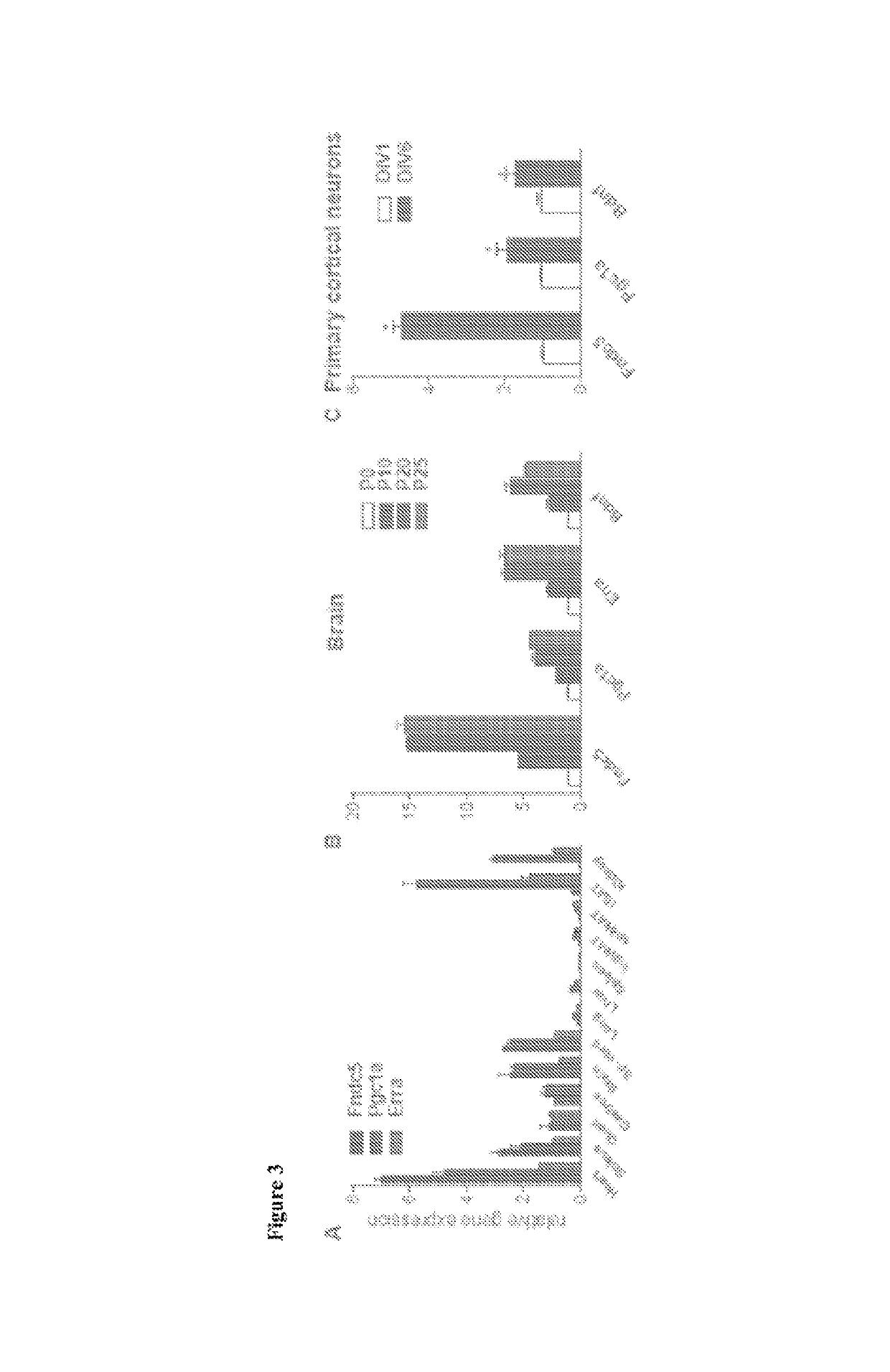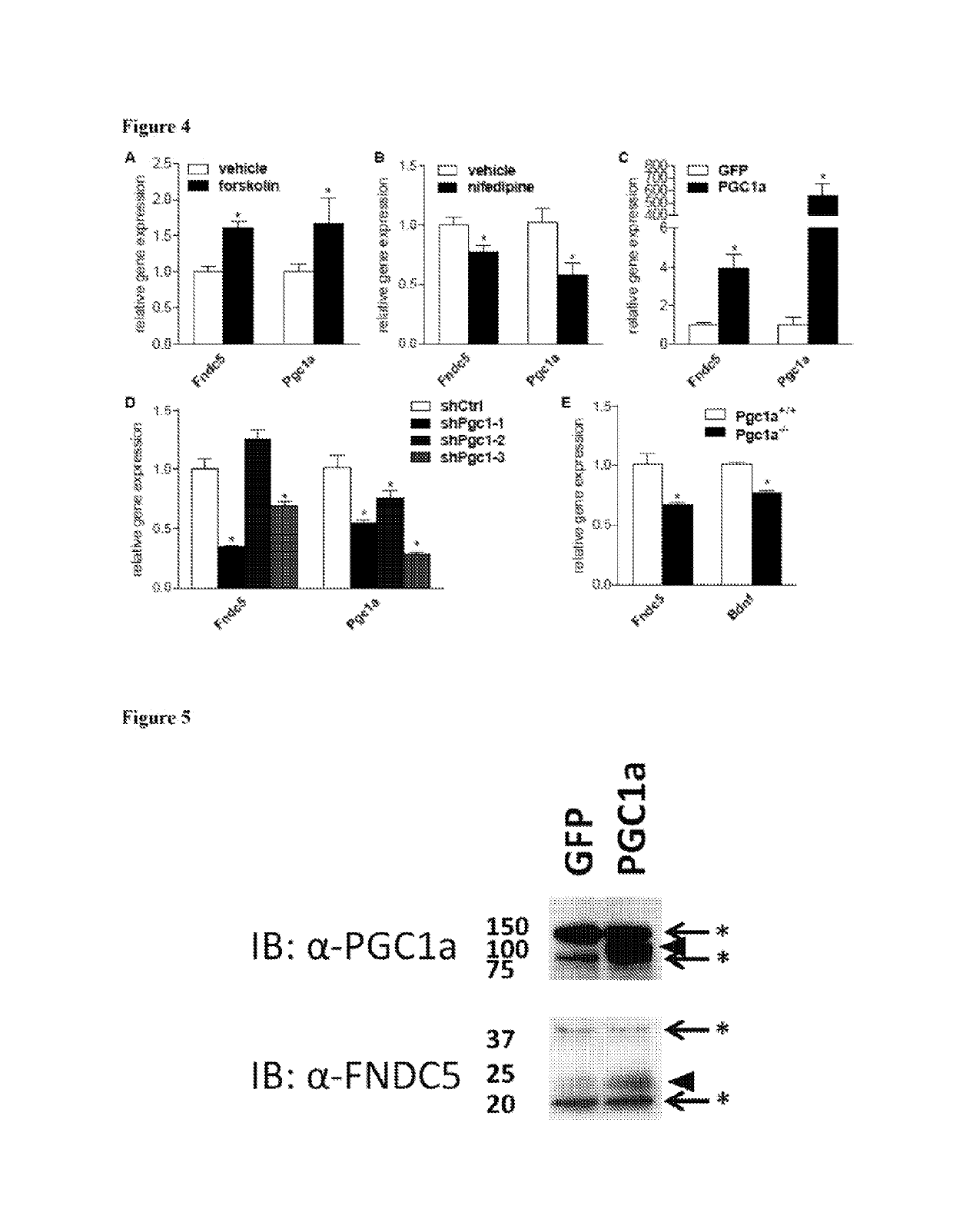Methods for the treatment of neurological disorders and diseases using FNDC5
a neurological disorder and fndc5 technology, applied in the direction of instruments, peptide/protein ingredients, genetic material ingredients, etc., can solve the problems of inability to administer neurotrophins themselves as therapeutics, the clinical trials of neurotrophins themselves have not been successful so far, and the associated disability is devastating for the sufferer, so as to increase the expression of bdnf, increase the survival rate of neuronal cells, and increase the effect of activity-induced immediate-early
- Summary
- Abstract
- Description
- Claims
- Application Information
AI Technical Summary
Benefits of technology
Problems solved by technology
Method used
Image
Examples
example 1
and Methods for Examples 1-10
A. Reagents
[0211]All primers used are listed with their sequences in Table 2. Recombinant human BDNF was purchased from PeproTech. Recombinant human GDNF and CNTF and forskolin were obtained from Sigma. Recombinant mouse IGF-1 was obtained, from R&D Systems. Recombinant mouse NGF and K252a were obtained from EMD Nifedipine, XCT 790, DY131, GW7647, and GW0742 were purchased from Tocris. Recombinant irisin (human, rat, mouse, canine) was obtained from Phoenix Pharmaceuticals (Burlingame, Calif.).
[0212]
TABLE 2PrimerSequence (5′ to 3′)mRps18 QSCATGCAGAACCCACGACAGTAmRps18 ASCCTCACGCAGCTTGTTGTCTAmFndc5QSATGAAGGAGATGGGGAGGAAmFndc5QAGCGGCAGAAGAGAGCTATAACAmPGC-1aQSTGATGTGAATGACTTGGATACAGACAmPGC-1aQAGCTCATTGTTGTACTGGTTGGATATGmErra QSCACTACGGTGTGGCATCCTGmErra ASACAGCTGTACTCGATGCTCCmErrb QSAACCGAATGTCGTCCGAAGACmErrb ASGTGGCTGAGGGCATCAATGmErrg QSATGGATTCGGTAGAACTTTGCCmErrg ASCTTCTTCGTAGTGCAGGGAAAAmBdnf QSTGGCCCTGCGGAGGCTAAGTmBdnf ASAGGGTGCTTCCGAGCCTTCCTmIgf1 QSTGGATG...
example 2
Exercise Induces Hippocampal Fndc5 Gene Expression
[0234]Although FNDC5 is highly expressed in the brain, as well as in skeletal muscle (Ferrer-Martinez et al. (2002) Dev. Dyn. 224, 154-167 and Teufel et al. (2002) Gene 297, 79-83), very little is known about its function in the brain. In order to investigate the effects of exercise on FNDC5 expression and function, an established endurance exercise regimen of 30 days of voluntary free running-wheel exercise was used. This regimen is known to induce BDNF expression, neurogenesis, dendritic spines and improved memory function in mice (Eadie et al. (2005) J. Comp. Neurol. 486, 39-47 and Kobilo et al. (2011) Learning Mem. (Cold Spring Harbor, N.Y.) 18, 605-609). As has previously been established, this training was sufficient to induce muscle Fndc5 gene expression (FIG. 1A), as well as the transcriptional regulators Pgc1a and Erra, known mediators of the exercise-response in skeletal muscle. In addition, other known genes of the exercis...
example 3
e Expression Correlates with Pgc1a Expression Levels in Various Tissues and Developmental Stages
[0235]It was previously reported that elevations in Fndc5 gene expression in exercised muscle was dependent on PGC-1α (Bostrom et al. (2012) Nature 481, 463-468). It was therefore investigated whether Fndc5 expression in the brain is also regulated by PGC-1α. To first assess if there is a correlation between the gene expression of these two proteins, different tissues were isolated from C57 / Bl6 mice, total RNA was extracted, and gene expression was measured for Fndc5 and Pgc1a. Consistent with earlier reports, the highest level of Fndc5 gene expression was detected in heart, skeletal muscle, brain and spinal cord (Ferrer-Martinez et al. (2002) Dev. Dyn. 224, 154-167 and Teufel et al. (2002) Gene 297, 79-83). When the different tissues were grouped according to their levels of Fndc5 expression, most tissues with very high Fndc5 expression also showed relatively high levels of Pgc1a gene ex...
PUM
| Property | Measurement | Unit |
|---|---|---|
| temperature | aaaaa | aaaaa |
| time-points | aaaaa | aaaaa |
| concentrations | aaaaa | aaaaa |
Abstract
Description
Claims
Application Information
 Login to View More
Login to View More - R&D
- Intellectual Property
- Life Sciences
- Materials
- Tech Scout
- Unparalleled Data Quality
- Higher Quality Content
- 60% Fewer Hallucinations
Browse by: Latest US Patents, China's latest patents, Technical Efficacy Thesaurus, Application Domain, Technology Topic, Popular Technical Reports.
© 2025 PatSnap. All rights reserved.Legal|Privacy policy|Modern Slavery Act Transparency Statement|Sitemap|About US| Contact US: help@patsnap.com



